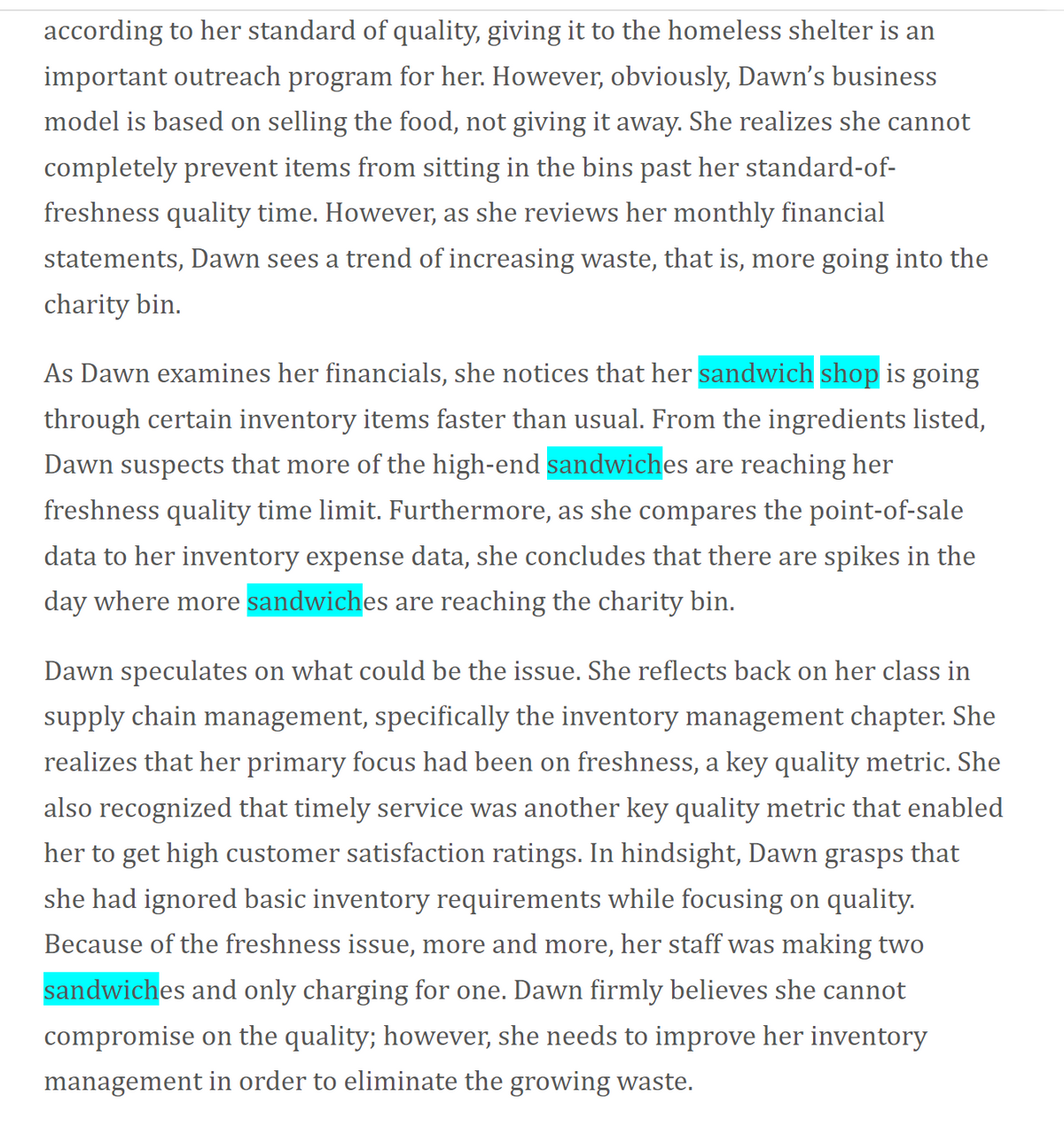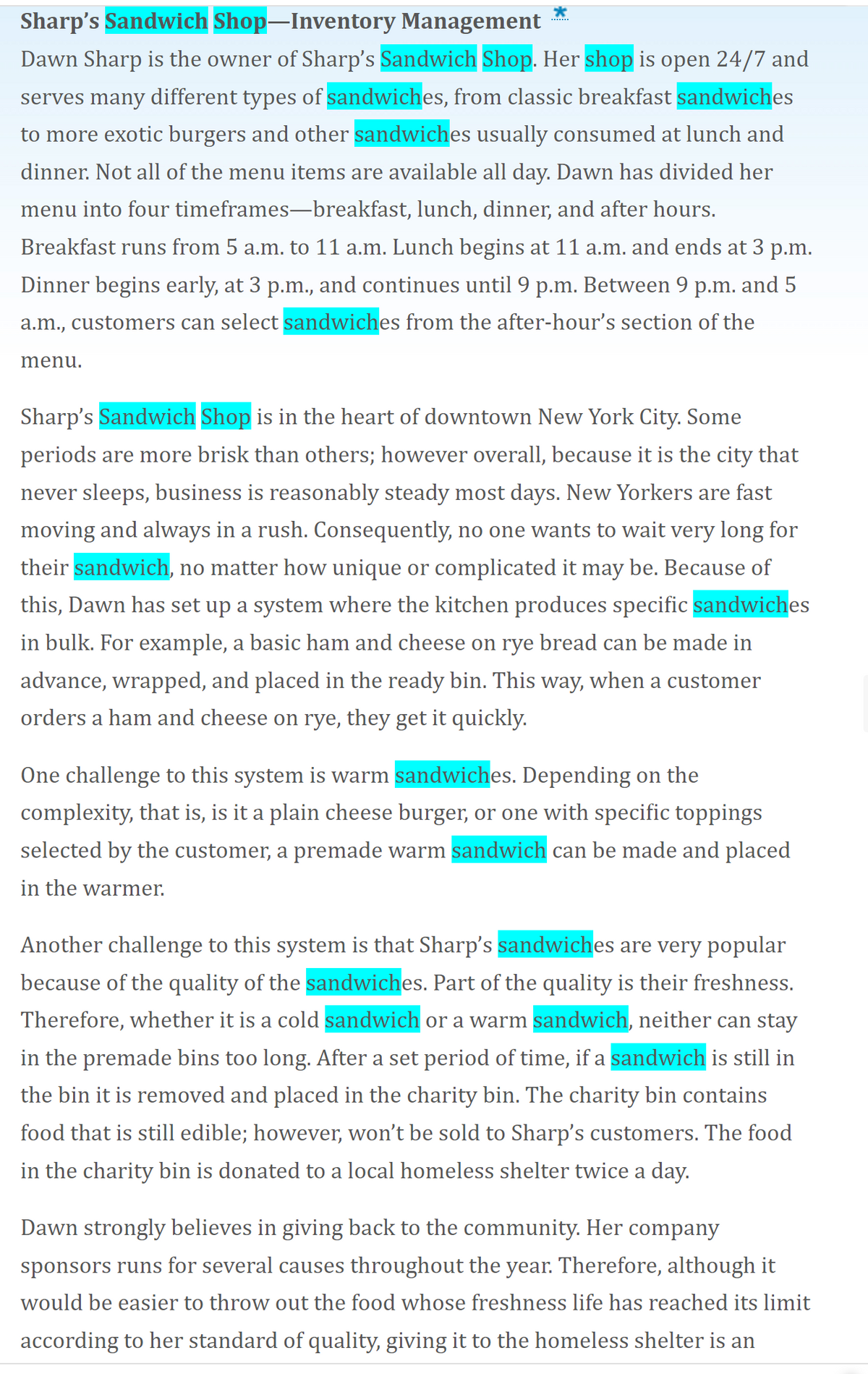1. Dawn understands her customers very well. She knows that they want two things: (1) speed in getting the sandwich, no matter what type and (2) the sandwich must taste fresh. As Dawn works out how to improve her inventory management process, how can she utilize the ABC inventory classification system as part of the remedy for this situation? • Think outside the box. Consider which type of inventory she really needs to classify using the ABC classification system. 2. As we examine this case, we know that the basic issue is low inventory turnover. Consequently, the bins are overstocked during specific times and items must be discarded because they exceed the freshness quality time limit. As she considers this point, Dawn is debating if she needs to use the EOQ model or the EMQ model. Provide a recommendation to Dawn on which model would be the most effective for her situation. Explain why your choice is better than the one you did not select. 3. Considering Sharp’s Sandwich Shop’s inventory issue, justify to Dawn what type of inventory review system she should establish. Go one step further, explain how this supports your previous answers to the above questions.
1. Dawn understands her customers very well. She knows that they want two things: (1) speed in getting the sandwich, no matter what type and (2) the sandwich must taste fresh. As Dawn works out how to improve her inventory management process, how can she utilize the ABC inventory classification system as part of the remedy for this situation? • Think outside the box. Consider which type of inventory she really needs to classify using the ABC classification system. 2. As we examine this case, we know that the basic issue is low inventory turnover. Consequently, the bins are overstocked during specific times and items must be discarded because they exceed the freshness quality time limit. As she considers this point, Dawn is debating if she needs to use the EOQ model or the EMQ model. Provide a recommendation to Dawn on which model would be the most effective for her situation. Explain why your choice is better than the one you did not select. 3. Considering Sharp’s Sandwich Shop’s inventory issue, justify to Dawn what type of inventory review system she should establish. Go one step further, explain how this supports your previous answers to the above questions.
Practical Management Science
6th Edition
ISBN:9781337406659
Author:WINSTON, Wayne L.
Publisher:WINSTON, Wayne L.
Chapter2: Introduction To Spreadsheet Modeling
Section: Chapter Questions
Problem 20P: Julie James is opening a lemonade stand. She believes the fixed cost per week of running the stand...
Related questions
Question
Hi please help me please,
Read the screenshot and answer the following questions:
1. Dawn understands her customers very well. She knows that they want two things: (1) speed in getting the sandwich, no matter what type and (2) the sandwich must taste fresh. As Dawn works out how to improve her inventory management process, how can she utilize the ABC inventory classification system as part of the remedy for this situation?
• Think outside the box. Consider which type of inventory she really needs to classify using the ABC classification system.
2. As we examine this case, we know that the basic issue is low inventory turnover. Consequently, the bins are overstocked during specific times and items must be discarded because they exceed the freshness quality time limit. As she considers this point, Dawn is debating if she needs to use the EOQ model or the EMQ model. Provide a recommendation to Dawn on which model would be the most effective for her situation. Explain why your choice is better than the one you did not select.
3. Considering Sharp’s Sandwich Shop’s inventory issue, justify to Dawn what type of inventory review system she should establish. Go one step further, explain how this supports your previous answers to the above questions.

Transcribed Image Text:according to her standard of quality, giving it to the homeless shelter is an
important outreach program for her. However, obviously, Dawn's business
model is based on selling the food, not giving it away. She realizes she cannot
completely prevent items from sitting in the bins past her standard-of-
freshness quality time. However, as she reviews her monthly financial
statements, Dawn sees a trend of increasing waste, that is, more going into the
charity bin.
As Dawn examines her financials, she notices that her sandwich shop is going
through certain inventory items faster than usual. From the ingredients listed,
Dawn suspects that more of the high-end sandwiches are reaching her
freshness quality time limit. Furthermore, as she compares the point-of-sale
data to her inventory expense data, she concludes that there are spikes in the
day where more sandwiches are reaching the charity bin.
Dawn speculates on what could be the issue. She reflects back on her class in
supply chain management, specifically the inventory management chapter. She
realizes that her primary focus had been on freshness, a key quality metric. She
also recognized that timely service was another key quality metric that enabled
her to get high customer satisfaction ratings. In hindsight, Dawn grasps that
she had ignored basic inventory requirements while focusing on quality.
Because of the freshness issue, more and more, her staff was making two
sandwiches and only charging for one. Dawn firmly believes she cannot
compromise on the quality; however, she needs to improve her inventory
management in order to eliminate the growing waste.

Transcribed Image Text:Sharp's Sandwich Shop-Inventory Management
Dawn Sharp is the owner of Sharp's Sandwich Shop. Her shop is open 24/7 and
serves many different types of sandwiches, from classic breakfast sandwiches
to more exotic burgers and other sandwiches usually consumed at lunch and
dinner. Not all of the menu items are available all day. Dawn has divided her
menu into four timeframes-breakfast, lunch, dinner, and after hours.
Breakfast runs from 5 a.m. to 11 a.m. Lunch begins at 11 a.m. and ends at 3 p.m.
Dinner begins early, at 3 p.m., and continues until 9 p.m. Between 9 p.m. and 5
a.m., customers can select sandwiches from the after-hour's section of the
menu.
Sharp's Sandwich Shop is in the heart of downtown New York City. Some
periods are more brisk than others; however overall, because it is the city that
never sleeps, business is reasonably steady most days. New Yorkers are fast
moving and always in a rush. Consequently, no one wants to wait very long for
their sandwich, no matter how unique or complicated it may be. Because of
this, Dawn has set up a system where the kitchen produces specific sandwiches
in bulk. For example, a basic ham and cheese on rye bread can be made in
advance, wrapped, and placed in the ready bin. This way, when a customer
orders a ham and cheese on rye, they get it quickly.
One challenge to this system is warm sandwiches. Depending on the
complexity, that is, is it a plain cheese burger, or one with specific toppings
selected by the customer, a premade warm sandwich can be made and placed
in the warmer.
Another challenge to this system is that Sharp's sandwiches are very popular
because of the quality of the sandwiches. Part of the quality is their freshness.
Therefore, whether it is a cold sandwich or a warm sandwich, neither can stay
in the premade bins too long. After a set period of time, if a sandwich is still in
the bin it is removed and placed in the charity bin. The charity bin contains
food that is still edible; however, won't be sold to Sharp's customers. The food
in the charity bin is donated to a local homeless shelter twice a day.
Dawn strongly believes in giving back to the community. Her company
sponsors runs for several causes throughout the year. Therefore, although it
would be easier to throw out the food whose freshness life has reached its limit
according to her standard of quality, giving it to the homeless shelter is an
Expert Solution
Step 1
Dawn noticed that some inventory goods in their sandwich store are being consumed faster than normal. Dawn believes that increasingly upscale sandwiches are getting to the end of their freshness quality time limit. She acknowledges that while concentrating on quality, she had disregarded fundamental inventory needs. Dawn is certain that she can't sacrifice quality, but her inventory management might need some work.
Trending now
This is a popular solution!
Step by step
Solved in 2 steps

Recommended textbooks for you

Practical Management Science
Operations Management
ISBN:
9781337406659
Author:
WINSTON, Wayne L.
Publisher:
Cengage,

Operations Management
Operations Management
ISBN:
9781259667473
Author:
William J Stevenson
Publisher:
McGraw-Hill Education

Operations and Supply Chain Management (Mcgraw-hi…
Operations Management
ISBN:
9781259666100
Author:
F. Robert Jacobs, Richard B Chase
Publisher:
McGraw-Hill Education

Practical Management Science
Operations Management
ISBN:
9781337406659
Author:
WINSTON, Wayne L.
Publisher:
Cengage,

Operations Management
Operations Management
ISBN:
9781259667473
Author:
William J Stevenson
Publisher:
McGraw-Hill Education

Operations and Supply Chain Management (Mcgraw-hi…
Operations Management
ISBN:
9781259666100
Author:
F. Robert Jacobs, Richard B Chase
Publisher:
McGraw-Hill Education


Purchasing and Supply Chain Management
Operations Management
ISBN:
9781285869681
Author:
Robert M. Monczka, Robert B. Handfield, Larry C. Giunipero, James L. Patterson
Publisher:
Cengage Learning

Production and Operations Analysis, Seventh Editi…
Operations Management
ISBN:
9781478623069
Author:
Steven Nahmias, Tava Lennon Olsen
Publisher:
Waveland Press, Inc.